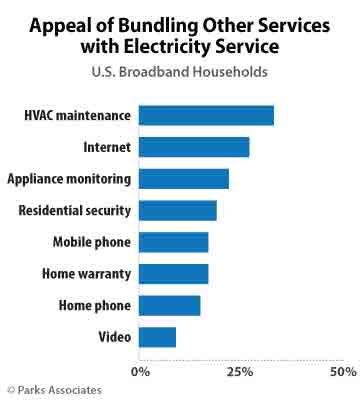Smart energy services in the home are already wrapped up with home security settings. Intelligent light bulbs and smart thermostats are standard offerings as part of smart home packages, which are led by security.
But people are ready for more, much more, according to new research from Parks Associates released at its Smart Energy Summit in Austin this week. Nearly half of homes with broadband in the U.S. would be willing to subscribe to a bundle of energy services for about $10 per month. Internet and HVAC maintenance were the most popular services to bundle with electricity services.

“Bundling together a group of services can expand product pricing and drive recurring revenue,” Tom Kerber, director of home controls and energy research for Parks Associates, said in a statement. “In addition, consumers are receptive to new business models such as demand response programs that offer manufacturers an ongoing revenue source that is not directly funded by the consumer.”
The information will be of interest to utilities, solar installers and telecoms, all of which are looking for increased revenue streams from customers. For eager customers, bundling is coming, albeit slowly.
Vivint is piloting wireless internet along with its home security and solar installation services. NRG and Comcast are teamed up in Pennsylvania for cable, internet and electricity. TXU Energy is rolling out notifications to customers to let them know if their HVAC or pool pump is on the fritz, courtesy of analytics powered by Bidgely. In the U.K., British Gas just acquired AlertMe to integrate more smart home services into its consumer offerings.
Although there is a lot of talk that utilities may be missing out on this opportunity to other players, such as telecom and security companies, there are so many ways that consumers are entering this market that it’s anyone’s game -- and utilities in deregulated markets could be particularly well positioned.
“Interest in smart energy solutions is strong, but in drilling down, no single offering is driving demand,” said Kerber.
The good news for utilities is that smart thermostats had the highest penetration of any device in 2014, so even if people aren’t buying them to forge a deeper relationship with their energy provider, that opportunity is there.



